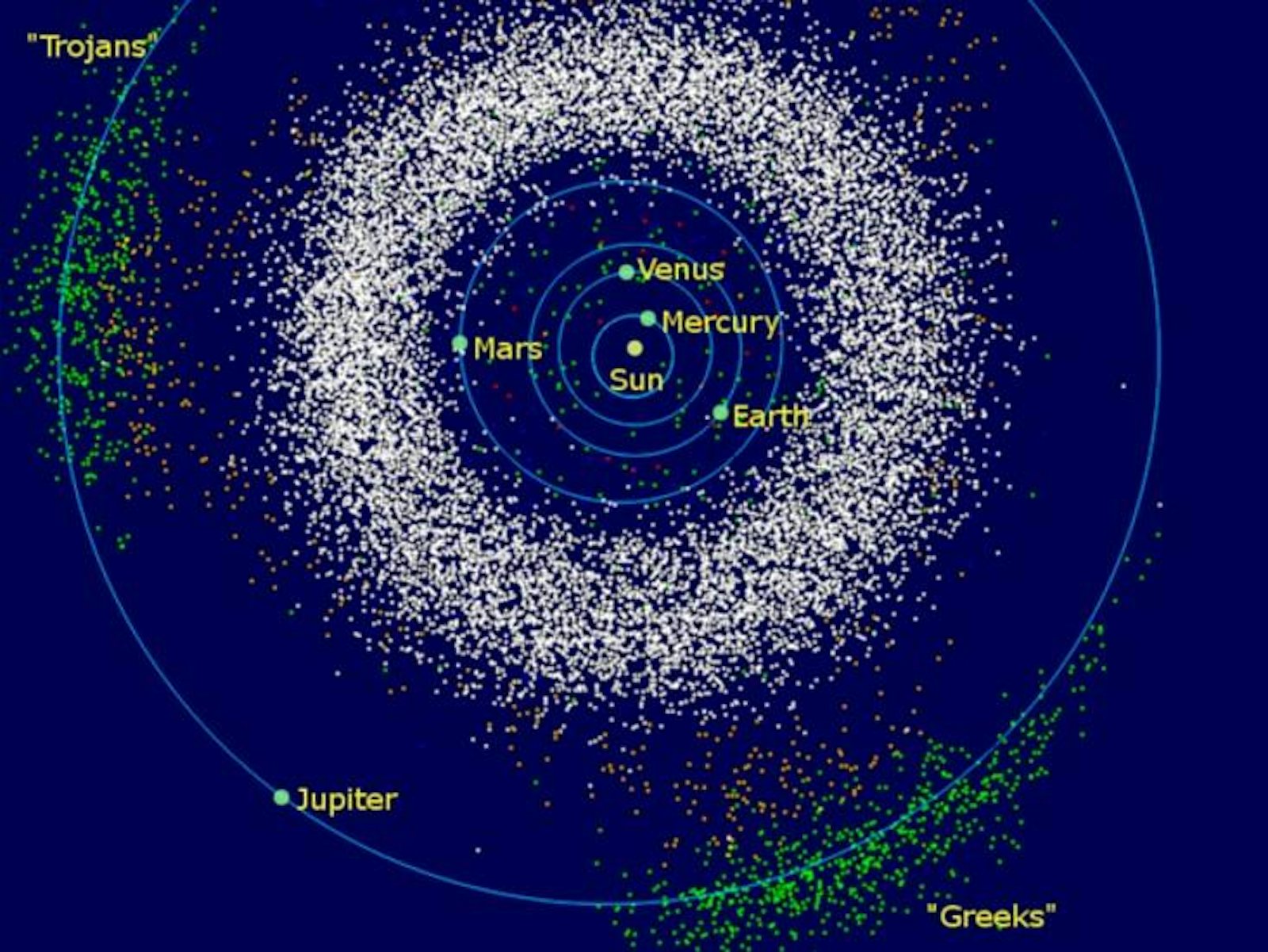There is an unsolved problem I want to tell you about: The case of the missing Trojans. You might be thinking of the mythical horse with soldiers hidden inside. Or maybe you’re thinking of a sports team. Or a type of computer virus, or, let’s be honest, of the condoms. (Note that I said, “Case of the missing Trojans,” not, “the Missing case of Trojans.”)
But there is another type of Trojan: an orbit. A swarm of thousands of asteroids share an orbit with Jupiter. They are not right next to the planet, like moons, but rather clustered in two clumps, one ahead of Jupiter on its orbit and one behind. The leading clump is called the “Greeks” and the trailing clump the “Trojans,” but they are usually just lumped together and simply called Jupiter’s Trojans. Many of them are named after mythological figures from the Trojan wars.
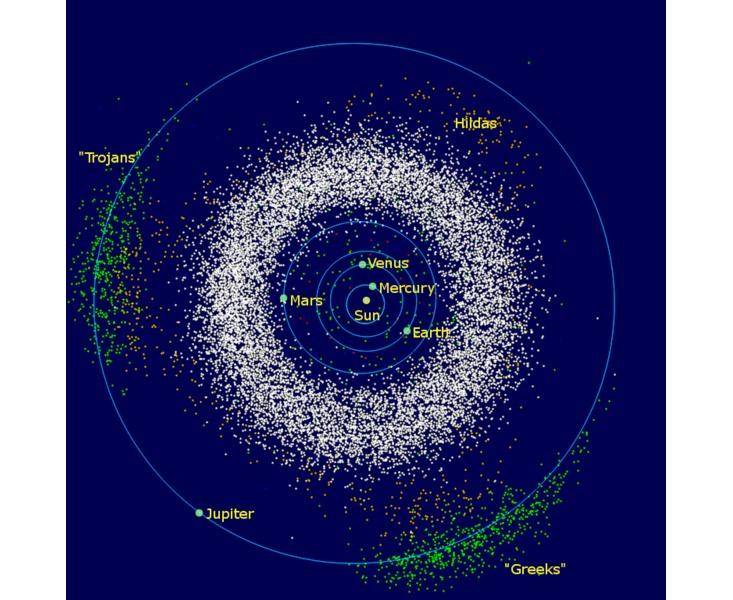
Jupiter is more than 300 times more massive than Earth. Its gravity has almost completely emptied out the asteroid belt, which we think once contained 1,000 times more material than it does now. How can these Trojans survive so close to a gas giant and yet remain on stable orbits?
It turns out that this was figured out way back in 1772 by French mathematician Joseph-Louis Lagrange. If we visualize a planet’s orbit around a star, there are a few special points where an extra body can orbit at the same rate as the planet. These are called the Lagrange points, and there are five of them, named L1 through L5.
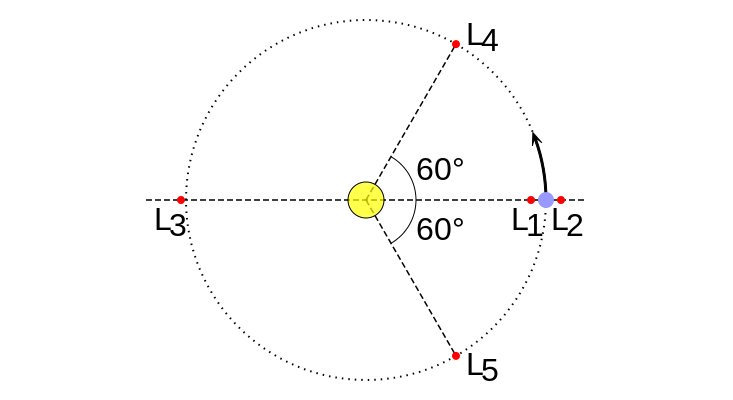
Only two of the Lagrange points are stable: L4 and L5. A body that is located at or near these points will happily orbit the Sun, remaining roughly 60 degrees in front or behind Jupiter. (More precisely, the extra body will actually oscillate with a typical amplitude of about 20 degrees around its Lagrange point, and there is even a class of orbit called a “horseshoe” that goes all the way around between L4 and L5.) Jupiter has Trojans simply because its L4 and L5 are stable despite the gravitational kicks of the other planets. They are islands of stability in a huge unstable ocean. If asteroids were sprinkled uniformly across the inner Solar System, the only ones that would survive near Jupiter are the Trojans.
Jupiter is not the only planet in the Solar System to have Trojans, although it has by far the most. Uranus (1 Trojan) and Neptune (13) each have them. So does Mars (7). And Earth even has one! Surprisingly, Saturn does not have any; the reason appears to be that Jupiter’s gravity de-stabilizes Saturn’s Trojans on millionyear timescales. Saturn’s Trojan island has sunk under the ocean of instability (though Saturn’s moons actually have four Trojan), as has Venus’.
Let’s take this Trojan idea a step farther. The objects trapped near the stable islands at L4 and L5 don’t need to be puny little asteroids. They can be full-grown planets! If two planets lie in the same orbit, separated by 60 degrees, they form a pair of Trojan planets.
Trojan planets are commonly found in computer simulations that try to explain how planets orbiting other stars (“exoplanets”) are created. Many of the known exoplanets have orbits very close to their stars. Astronomers think that many of these planets formed farther away and were pushed closer in by a process called orbital migration. It is the disks of gas and dust from which the planets were born that are causing the planets to migrate. And it is during this migration that adjacent planets can be trapped in Trojan configurations. Trojan planets don’t form during every simulation but they do pop up every third or fourth time.
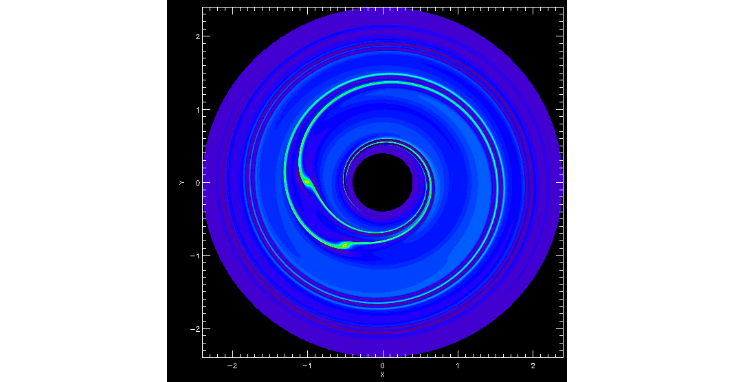
So we think that Trojan planets should exist. We don’t have any in the Solar System, but Trojan planets should definitely exist around other stars, and they should be detectable with current telescopes! The best tool for the job is Kepler, NASA’s planet-finding space telescope extraordinaire. So what has Kepler found?
Drumroll…and a big frowny face. Kepler has not found any Trojan planets. There was one announced discovery of a four-planet system called KOI-730 (now named Kepler-223) with two Trojan planets sharing an orbit plus two more planets, one interior and one exterior to the Trojan pair.
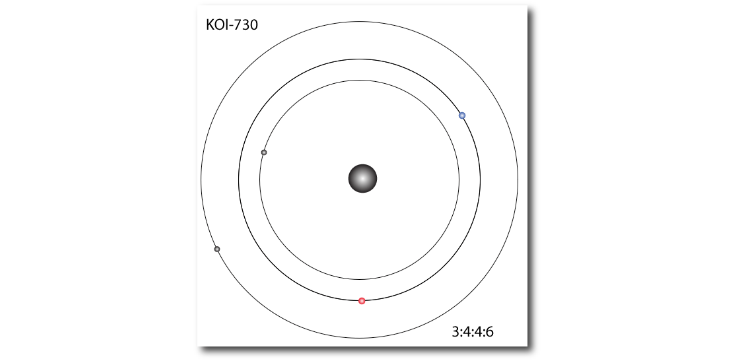
Unfortunately, this system was later determined to be in a different configuration with no Trojan planets. Bummer.
The search for Trojan exoplanets has been ongoing for several years, and it continues, but things are looking grim. Trojan planets are supposed to be relatively easy to detect, so their absence stands out. It’s a cosmic mystery: The case of the missing Trojans!
So why aren’t we finding any Trojan planets? There are two possibilities: Either the Trojans are there but we aren’t finding them, or they simply aren’t there.
Could Trojan pairs be harder to find than we thought? Well, two planets on the same orbit each produce a signal with the same frequency and, if you aren’t expecting this, it can make both planets look like noise. But we are expecting it. Plus, the gravitational tug of war between Trojan planets also changes the phase of their signal, but we know this, too, and can actually use it as a tool to try to find Trojans.
Perhaps Trojan configurations are destroyed either as planets migrate inward or, for planets very close to their stars, because of tidal interactions between the planets and star. However, these destruction mechanisms should only affect a small fraction of the planets that Kepler is finding.
My own pet theory goes like this. Planets migrate inward in cohorts, often with Trojan pairs. But when the gaseous protoplanetary disk dissipates, the orbits of the migrated planets go haywire. There is a phase of giant collisions between planets that both destroys Trojan pairs and re-organizes the orbits of the survivors. This model matches what we see in the dataset of exoplanets, so that’s encouraging. Plus, once in a while, planets migrate in and do not go haywire, so according to the model there should indeed be some Trojan pairs out there, and we can predict where we should find them. Of course, it’s just a model so we’ll see how it stands the test of time, as more data floods in.
Sean Raymond is an astronomer studying the formation and evolution of planetary systems. He also blogs at planetplanet.net.



















